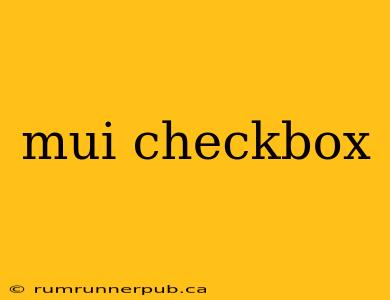Material-UI (MUI) offers a robust and customizable Checkbox component, simplifying the creation of interactive forms and user interfaces. This article delves into the intricacies of MUI Checkboxes, drawing upon insightful questions and answers from Stack Overflow, and expanding upon them with practical examples and additional context.
Understanding the Basics
MUI's Checkbox component provides a visually appealing and accessible way to allow users to select one or more options. At its core, it's a controlled component, meaning its state is managed by your React application.
Example (Basic Checkbox):
import * as React from 'react';
import Checkbox from '@mui/material/Checkbox';
export default function BasicCheckbox() {
const [checked, setChecked] = React.useState(false);
return (
<div>
<Checkbox
checked={checked}
onChange={(event) => {
setChecked(event.target.checked);
}}
inputProps={{ 'aria-label': 'controlled' }}
/>
</div>
);
}
This simple example demonstrates the fundamental structure: checked tracks the checkbox's state, and onChange updates this state whenever the checkbox's value changes. The inputProps are crucial for accessibility, ensuring proper labelling for screen readers.
Handling Complex Scenarios: Insights from Stack Overflow
Let's explore some common challenges and their solutions, inspired by Stack Overflow discussions:
1. Customizing Checkbox Styling:
A frequent question on Stack Overflow centers around customizing the appearance of MUI Checkboxes. While MUI provides default styling, you might need to adjust colors, sizes, or add icons. This can be achieved using the sx prop for inline styling or by creating custom CSS classes.
(Inspired by numerous Stack Overflow questions regarding MUI Checkbox styling)
Example (Custom Styling with sx):
<Checkbox
sx={{
color: 'red',
'&.Mui-checked': {
color: 'green',
},
}}
checked={checked}
onChange={(event) => setChecked(event.target.checked)}
/>
This example changes the unchecked checkbox color to red and the checked color to green. The &.Mui-checked selector targets the checked state specifically.
2. Implementing Indeterminate State:
MUI Checkboxes support an "indeterminate" state, visually represented by a partially checked appearance. This is useful when dealing with hierarchical checkboxes or situations where some, but not all, child elements are selected.
(Addressing common Stack Overflow questions about the indeterminate state)
Example (Indeterminate Checkbox):
<Checkbox
indeterminate={indeterminate}
checked={checked}
onChange={handleChange}
/>
Remember to manage the indeterminate state appropriately in your application logic based on the selection of child elements.
3. Using Checkboxes within a Form:
Integrating checkboxes into forms requires careful consideration of state management and form submission. MUI's FormControlLabel component provides a convenient way to associate a label with your checkbox, improving both usability and accessibility.
(Building upon solutions found on Stack Overflow related to form integration)
Example (Checkbox within a Form):
import FormControlLabel from '@mui/material/FormControlLabel';
<FormControlLabel
control={<Checkbox checked={checked} onChange={handleChange} />}
label="Agree to Terms"
/>
This cleanly combines the checkbox with its descriptive label. Remember to handle the checked state appropriately when submitting your form.
Beyond the Basics: Advanced Techniques
- Grouped Checkboxes: Use arrays to manage multiple checkboxes and their states efficiently.
- Disabled Checkboxes: Set the
disabledprop to prevent user interaction. - Conditional Rendering: Dynamically show or hide checkboxes based on application state.
- Accessibility: Always provide clear labels and ensure proper ARIA attributes for screen reader compatibility.
Conclusion
MUI's Checkbox component is a powerful tool for creating interactive and user-friendly interfaces. By understanding its core features and leveraging the wealth of knowledge available on Stack Overflow, you can build sophisticated and accessible forms and applications. Remember to prioritize accessibility and robust state management for a positive user experience. This article provided a foundation; continuous exploration and experimentation will further enhance your mastery of MUI Checkboxes.
